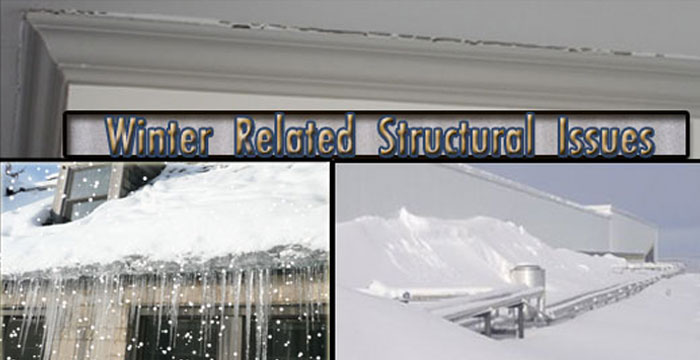
Past winters saw snow on the ground continuously from November through March, with several significant storms, as well as cold temperatures and dry air continuously from November through March. Snow, and snow accumulation, is certainly an issue of concern for both residential and commercial roofs. We receive many calls each winter with questions regarding the safety of roofs and questions regarding cracking observed in ceilings.
Light Framed Residential Structures
In light framed residential structures, such as single family houses, cracking can occur in and around molding, trim and drywall ceilings due to cold and dry weather, which tends to cause building materials to shrink. As these building materials shrink at different rates from each other, or shrink at points of contact, cracks and gaps can emerge. This is similar to the phenomena of doors being sticky and tight in the summer when the weather is hot and humid and operating properly in the winter when the weather is cold and dry. This is not to say that cracking which occurs in the winter, especially when snow is on the roof, should not be of a concern. Any cracking beyond hairline should always be evaluated by a Licensed Professional Engineer.
Snow on a roof is less of a concern in residential structures with sloped roofs than on commercial structures with flat roofs. A sloped roof generally will shed snow due to its slope. This is even accounted for in the building code requirements for snow loads on roofs. Lower loads are usually used on sloped roofs and the load is proportional to the pitch of the roof. Frozen snow and water on the roof can prevent snow from sliding off a roof and this could, in addition to causing leaks from ice damage, cause an overload of the roof. In general, residential light framed roofs have high factors of safety and, even if the design loads are somewhat exceeded, will not collapse. This is not to say they cannot collapse, as there are many variables. Indications of distress on a residential roof include sagging of the roof rafters and/or ridge. Small tears on the bottoms of the roof rafters are indications that failure is beginning to occur. Tears can be visible due to the lighter color of the freshly exposed wood. A lowering or sagging of the roof ridge or a pulling apart of the rafters to ridge connections can also be an indication of an overstressed roof. If any tears or pulling apart of connections occur, the structure should not occupied and a Licensed Design Professional should be contacted to assess the structure immediately. Removing snow from a roof, either at the bottom of the slope to allow snow to slide, or from the entire roof, is usually a good course of action, but we would not advise standing on the roof to remove the snow.
Commercial Structures
Commercial flat roofs in strip malls or big box retail typically have much lower factors of safety inherent in their materials and design. This is due to the fact that they are always designed by a design professional and are constructed under much stricter requirements than residential structures. Flat roofs also have a higher snow load on them due to the fact that snow cannot shed off the roof. If a flat roof has parapets preventing drainage over the side of the roof and is drained only by internal roof drains, significant weight can accumulate on the roof if the drains become frozen or clogged. Melting snow and refreezing water can clog drains. This can cause ice and denser snow to accumulate on the roof. In turn, this can cause more deflection of the roof, creating more of a bowl shape, which could make more room for water, ice and snow to accumulate on the roof. Building owners must maintain their flat roofs and drainage under snow and ice conditions. This typically entails daily, or multiple times daily, depending on the weather conditions, clearing of the area around the drains and verifications that the roof is draining, as well as monitoring of the roof from below. Indications that a roof is sagging could include dropping of sprinkler heads below the dropped ceiling. This occurs when the sprinkler system is hung from the main roof and a dropped ceiling is supported on a different support system.
This is an informational article only. It does not constitute engineering advice or services and it should not be used as such. It is intended to give general information to clients and answer many of the typical questions we receive. It is also intended to serve as a reference to the General Public. DO NOT use the information presented here to attempt to diagnose any problem or make any engineering judgments. It is general in nature and does not necessarily apply to your situation. Only a Licensed Design Professional can make a proper assessment of your situation.
